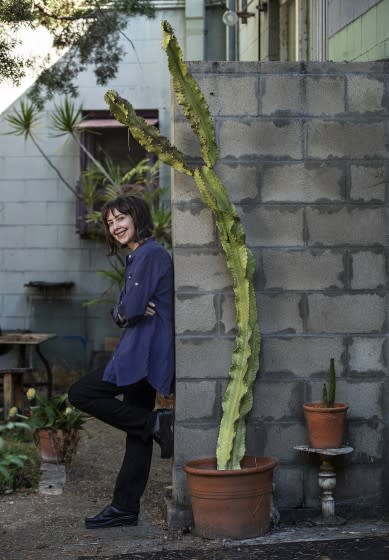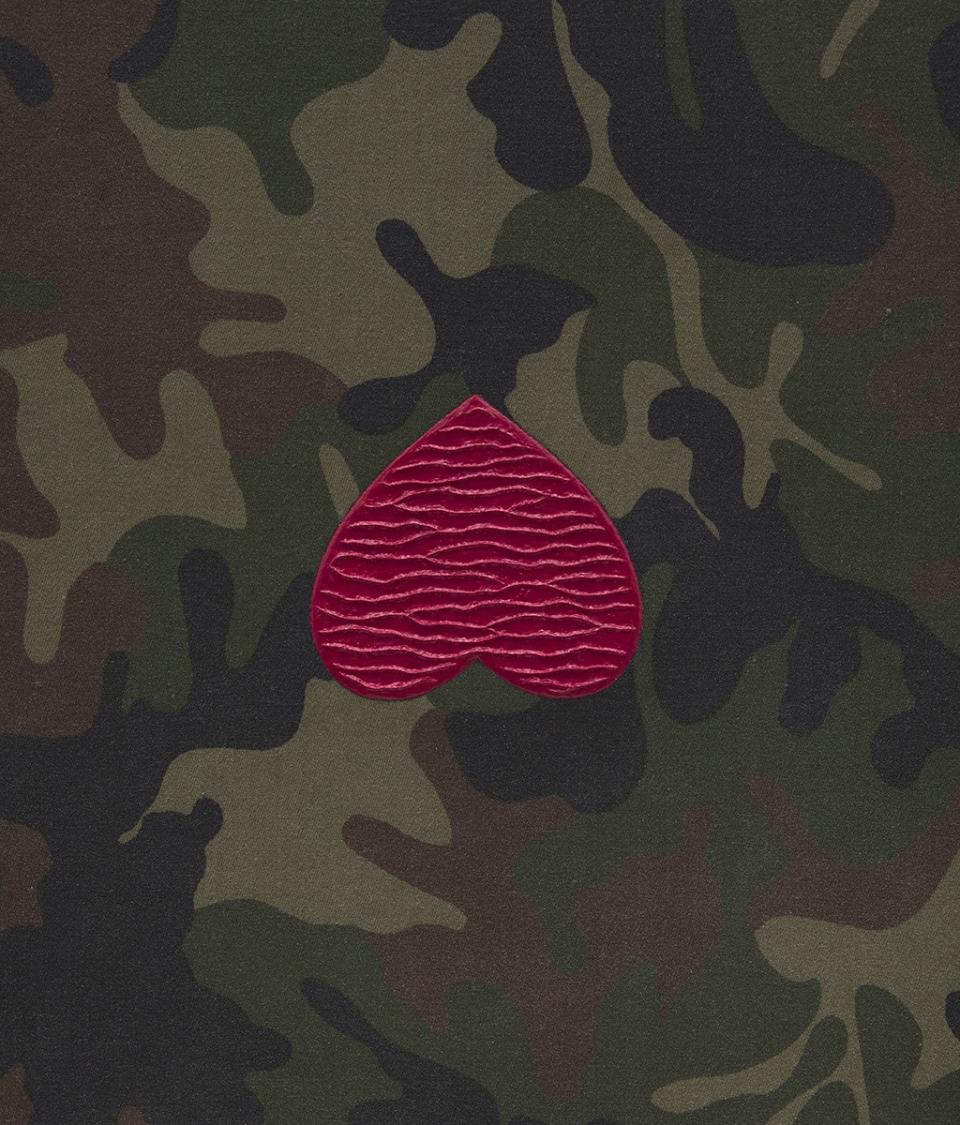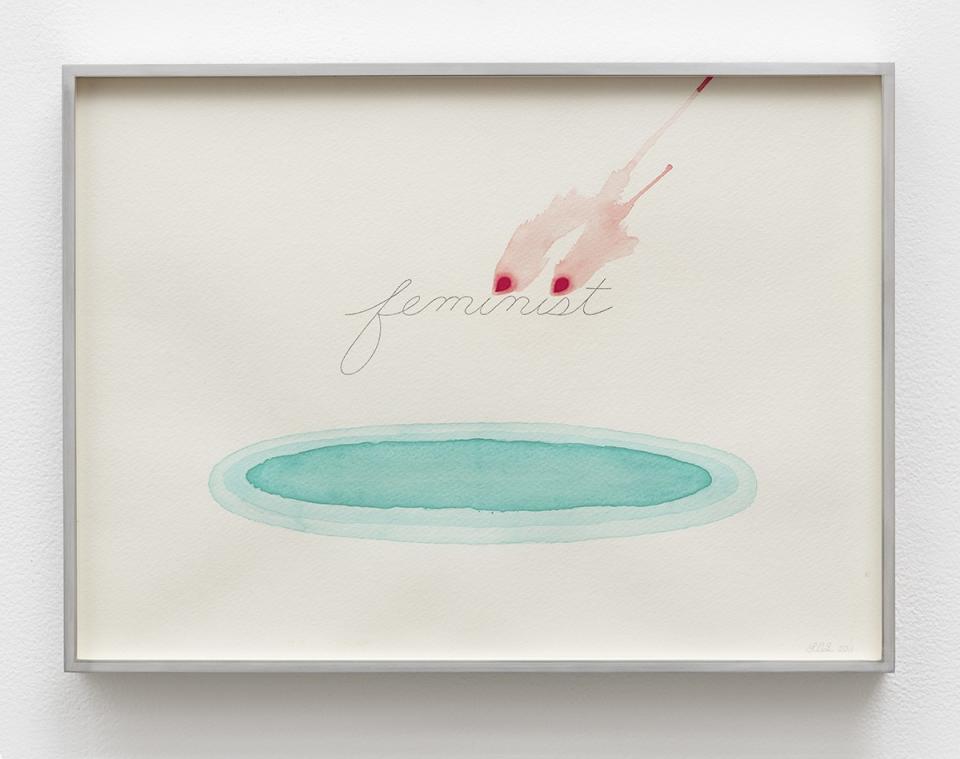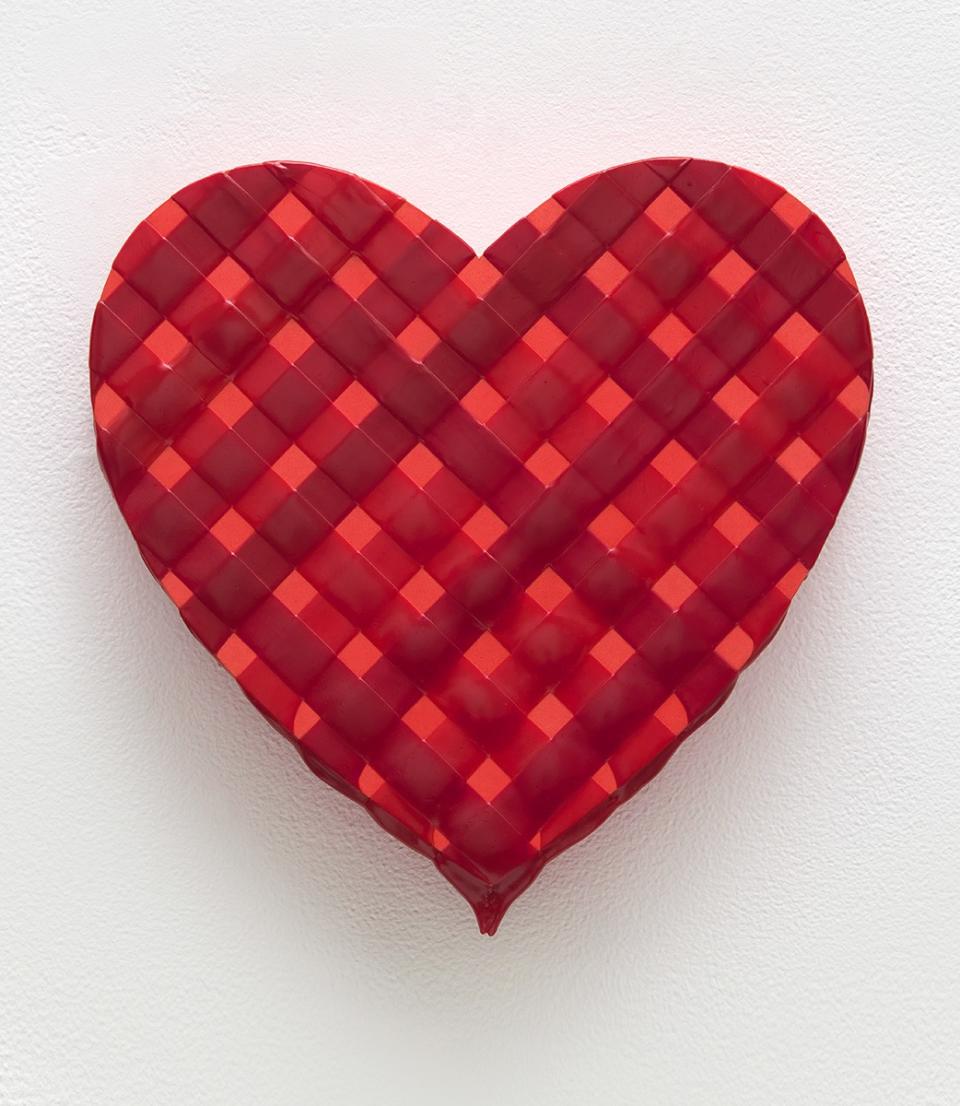How Linda Stark transforms kitschy hearts into visceral symbols of love and valor

Among the ancient Egyptians, the heart was considered the seat of a person's intelligence. In the Judeo-Christian tradition, it serves as a symbol of the conscience. Since at least the Middle Ages it has been associated with various forms of love — platonic, spiritual and romantic. Its depiction as a pictogram — resembling a crimson upside-down pear — likely dates back to the medieval era, if not classical antiquity.
Of course, in the modern era the heart symbol is used amorously (Valentine's Day), as well as in civic contexts — such as Milton Glaser's "I Heart New York" design. Heart symbols can now be conjured at the tap of a finger: The iPhone emoji palette features 19 types of heart.
All of this might make you think that the heart is played out in art. But one look at painter Linda Stark's solo exhibition "Hearts" at David Kordansky Gallery, her first at the space, may lead you to believe otherwise.
A small installation of the L.A. artist's works — now in its final week — occupies a new, 2,000-square-foot addition to the gallery by architect Kulapat Yantrasast of wHY Architecture. The intimate space couldn't be a better fit for Stark's taut little works, which, though small in scale, pack a painterly punch. (The biggest of her canvases caps out at 20 inches.)

Works that from a distance appear to be inspired by flat graphic designs are, on closer inspection, deeply textured. Paint is woven and layered and allowed to accrete in ways that evoke human flesh. A heart bearing an abstracted pattern is actually laden with burrs; another is painted on a repurposed army jacket. A highly stylized sacred heart bears the outline of the female reproductive system surrounded by a cushion of bloody red paint.
"It's branded in the painting," says Stark, as if it were "inside the body."
Hearts in all their guises appear in the works — as symbols of love, as symbols of fertility and power, and as symbols of valor. The 2018 canvas "Purple Heart," which depicts the military medal awarded to those wounded or killed while serving, is depicted in Stark's version with clover flowers.
A separate gallery of drawings further delves into her interests; there are wry plays on color, the female body and words. A drawing titled "Painting (stigmata)," from 2013, literally punctures the word "painting" with dauntingly precise holes trimmed in blood red.
In Stark's hands, painting is back from the dead.

Born in San Diego, Stark, 64, moved to Los Angeles in 1988.
Her paintings were featured in the 2018 "Made in L.A." biennial at the Hammer Museum. Early next year (if post-pandemic reopenings go according to plan), they will materialize in "New Times: Art and Feminisms in the 21st Century" at the Berkeley Art Museum and Pacific Film Archive.
The show at Kordansky comes at a poignant time, in the midst of a pandemic and in the wake of her husband's death just last year. (Don Suggs was also an artist — and the subject of a solo show at L.A. Louver this past summer.)
In this interview, condensed and edited for clarity, Stark talks about how she comes to her subjects — be it hearts, feminism or cats.
How did hearts emerge as a theme?
They've been on my radar for a while. My first painting of a heart was in the '90s. I made some works on paper in the show: "I Heart NY" in 2012 and "Fly Paper Heart" in 2014.
In 2015, I started the first three for the show: "Telltale Heart" and "Spade," which wasn't included, and "Purple Heart." In 2018, I decided to focus exclusively on fleshing out the series of hearts. They were all underway when [Don] died in 2019, and the series seemed strangely relevant to the event.

It's the common pictogram of a heart that you work with — not the anatomical representation.
The challenge of making an interesting painting about a heart is something I really liked. It's one of the most popular symbols in the world. I was investigating famous hearts, like those on medals or chocolate boxes — or those in stories, like "Telltale Heart" [inspired by the short story of the same name by Edgar Allan Poe]. I just didn't get into the anatomical heart. I was more interested in the popular references of famous hearts.
The female reproductive system also makes regular appearances in your work. What keeps you coming back to ovaries?
It began as my personal "women unites" symbol. The first painting I did was called "Coat of Arms," and it was a woman's coat of arms — not based on patriarchal symbols. It had all of these blood-red drips. The female reproductive system is this emblematic heraldic form. It's reminiscent of a horned animal. [That painting] was originally inspired by the endometrium diagram in a graphic on the four stages of the menstrual cycle in "Our Bodies, Ourselves." I incorporate the processes that come from menstruation. For me, they symbolize regeneration and woman power.
Your paintings incorporate other materials: an army surplus jacked, old flypaper, burrs. Do you seek out materials to include in a painting? Or do the objects inspire the work?
In "Purple Heart," the clover flowers — those I found in Griffith Park. I'd been keeping my eye out to find the right flowers for that painting. I had to find the right flowers, dry them and adhere them to the painting. The burrs are from the L.A. River reeds that grow in my backyard, and the flypaper was hanging in Don's studio. I wanted to memorialize the flying creatures in that fly paper. It was like a readymade amber. The flypaper and the burrs were in my immediate environment, so it was seeing them daily that familiarized me with the material.
These [materials] are non-illusionistic, so they set up a direct or actual presence. They are a burr or a bug. I had the idea for "Telltale Heart" [a painting of a heart on camouflage], and I intentionally sought out an army jacket at an army surplus store. Objects have a record, they have a feeling because of the history they've had — and I wanted it to carry the energy of war. There are so many camouflage patterns out there that are high fashion. And I wanted it to be an actual jacket that had been to war and back. The painting is many things. It is also an antiwar statement.

How do you arrive at the images that you paint?
Ideas can be stimulated from my environment — like the cat paintings. I have a few. Those are all posthumous portraits. They were my cats and they died. I painted a portrait so I could heal from their death. Or an idea pops into my head and I jot it down. Or the organic process of one idea or drawing begets the next.
You frequently depict words too.
I choose personally charged words — words I'm passionate about. I do paintings with words like "painting" and "feminist." I chose the word "painting" because when I was in grad school — other painters have had this experience too — painting was dead. Many painters have heard disparaging remarks. Yet painting has always been challenging and has always been an important part of my life. Painting is really difficult, yet the activity produces joy.

The drawing titled "Painting (stigmata)" is punctured with holes marked with red ink. Why stigmata?
It's devotional. I wasn't raised with religion. I come to religion and Catholic images as an outsider — but with a reverence for loaded imagery. So, like the feminist "Stigmata" painting [which shows the word "feminist" embedded in the palm of a hand, shown at the Hammer in 2018], it was about the devotional aspect of being a feminist and having it branded into my palm.
You have a series of paintings that look woven yet they are made of paint. How do you create that illusion?
It's a process I invented in 1990. I made my first weave painting, and it's because I was working as a temp at a local law firm in downtown L.A. and they had a lobby floor that was wood and it was woven. I thought, if they can weave wood, I can weave paint. There was a lot of trial and error. But it's actually woven. The process is labor intensive. I was temping, barely surviving — I'd spend hours on one drip. They were like mantras or personal prayers. [Weaving] also relates to women's work.

In an interview with Hyperallergic, you said you grew up seeing your mother's paintings. Was she an artist?
My mom got her B.A. in art at Chapman College [now Chapman University]. She was a painter. Then she married and had six kids. So when she could find the time, she would paint furiously on the weekend and my dad would run interference to keep the kids away. There were landscapes. She did some portraits of family members too. But I remember the process. She only had a little bit of time to do what she did, and she was extremely intense in that activity and I would see it.
What made you settle on painting as something you might want to do?
I fell in love with painting in a class with professor Cornelia Schulz at UC Davis. She made paintings seem like a magical process. I had done a lot of photography, but I hit a dead end because of my technical ability. So my photo teacher suggested I take painting. I just loved it. It was an alchemical process. And I didn't feel like it was a dead end for me. I had ideas that were generated through that medium and that's key. My ideas with photography were limited.

Your late husband was a painter. How did you shape each other's work?
We had a real dialogue. We were both fiercely independent yet complementary. His studio was the entire downstairs of the building and mine is upstairs. We left each other alone unless asked. We gave each other the freedom to do whatever we wanted. But then we would call on each other when we were stuck. And we told the truth. That is very rare, to get the truth. We both valued truth.
He was the one who inspired me to draw. I had broken my leg and he set me up. Also, his overall knowledge of art, his critique, that is something I truly miss. He shaped my life in that way.
What's been your recipe for mentally navigating Contagion 2020 and Election 2020?
I limit my news intake. I talk to friends, but the best thing for my mental health is to be immersed in the studio. It's my secret garden.
This story originally appeared in Los Angeles Times.


